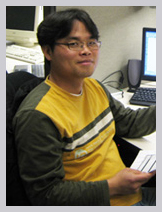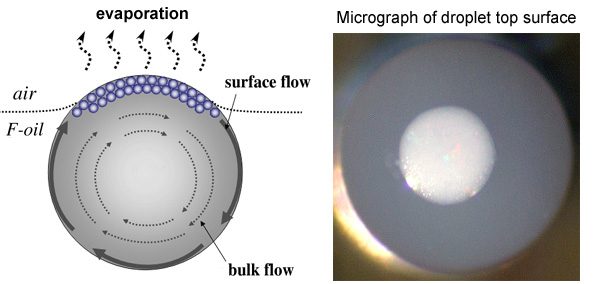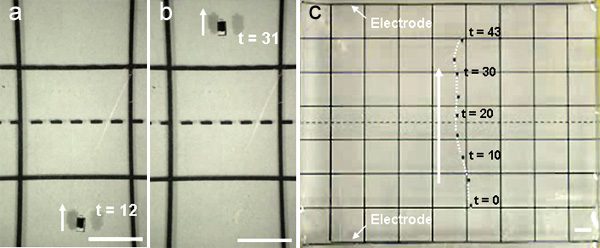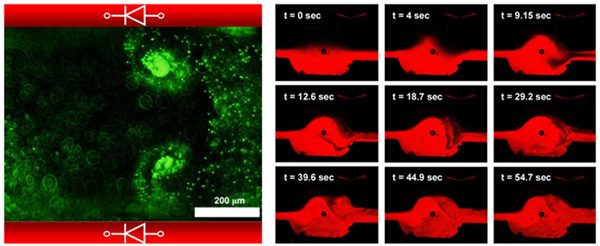Suk Tai Chang
| PhD, Chemical Engineering, 2008 North Carolina State University M.S., Chemical Engineering, 2001 Gwangju Institute of Science & Technology, Korea B.S., Chemical Engineering, 1999 Chung-Ang University, Korea Present Site |  |
Research Focus: Manipulation of Fluids and Particles on the Micro-scale with Evaporation-induced, Dielectrophoretic and Electrokinetic Forces
Evaporation-Induced Particle Micro-separations inside Freely Floating Droplets
Droplet-based microfluidic systems have emerged as a promising technology for solving some of the drawbacks of channel-based devices, such as channel clogging with suspended particles or biomolecules, poor mixing and difficulty of particle separation. Our group developed a dielectrophoretic liquid-liquid chip system for capturing and manipulating micro-sized droplets freely suspended on the surface of a dense fluorinated oil.
This project is devoted to the study of unusual phenomena of colloidal particle transport and separation inside floating microdroplets. Microspheres suspended in a drying droplet on our chip were rapidly separated in the droplet’s top region owing to water evaporation, which induced internal hydrodynamic flow inside the drying droplet (Figure 1). During the evaporation process, a surface tension gradient on the droplet surface occurred as a result of a non-uniform temperature distribution within the droplet. This interfacial gradient generated an internal convective Marangoni flow inside the evaporating droplet. The suspended colloidal particles driven by the internal convective flow were collected at the top of the droplets by the internal hydrodynamic flux compensating for the evaporation.

Figure 1: Schematic of the proposed mechanism of circulation and particle microseparations in evaporating droplets (left). Typical micrograph of an evaporating droplet, containing white latex microshperes, from a top-down perspective (right).
The internal flow pattern and temperature distribution within the evaporating droplet were simulated using finite element calculation with FEMLAB software. The resulting internal flow of the simulation was consistent with the experiments using tracer particles (see Figure 2, Movie 1). These remarkable phenomena could be used for on-chip ‘droplet engineering’ process where the micro-sized droplets are used as sites for materials synthesis and innovative microfluidic systems for microbioassays.

Figure 2: (a) Experimental images of the internal flow in the evaporating water droplet viewed from aside. The image in (b) is taken after a 90° change in perspective from (a). The tracers are polymer microrods synthesized in our group. Scale bar = 200 um. (c) Computed temperature distribution and flow profile inside a drying droplet on our chip. The flow profile is represented by the arrows and colors show the temperature.
Remotely Powered Self-Propelling Particles and Novel Microfluidic Systems Based on Miniature Diodes
Micromachines and microsensors that are capable of self-propulsion through fluids could revolutionize many aspects of technology. It has been recognized that many of the principles for propellency do not easily scale to microscopic dimensions, where viscous effects and reversibility of fluids predominate and render almost all mechanical means of propulsion inefficient.
This project is devoted to the study of an alternative mechanism of self-propelling motility based on electro-osmotic propulsion force and the extension of this propulsion force to innovative microfluidic pump/mixer. Various types of miniature semiconductor diodes floating in water act as self-propelling particles when powered by an external AC electric field. DC voltage across the diodes as a result of rectification of the external AC field leads to particle localized electro-osmotic flow. The resulting reactive force pushes the diodes in the direction opposite to the electro-osmotic flux. The microelements began to move parallel to the electric field in the direction of either the cathode or the anode, depending on their surface charge (Figure 3). In effect, the semiconductor microelements harvest electric energy from external AC field and convert it into mechanical propulsion on the microscale.

Figure 3: Optical micrographs of self-propelling semiconductor particles: (a,b) Consecutive images demonstrating how a diode 1 mm in size self-propels to the top (c) Overlay of a series of photographs at low magnification showing the 5 cm “voyage” of a microdiode (seen here as small black rectangle). Scale bars are 5 mm.
The particle localized propulsion force can be used in diode-actuated electro-osmotic motors and actuators. We constructed ‘gear’ powered by a ring of diodes converting the energy of the external field into rotational motion. Diodes embedded in microfluidic channel walls provided locally distributed pumping or mixing of microfluids powered by a global AC external field (Figure 4).

Figure 4: Optical micrograph illustrating pumping and backflow for diodes with the same orientation. The diodes create a unidirectional flow by moving the liquid adjacent to the wall in the same direction (left). Micrograph illustrating the flow generated by two diodes with opposite orientation. The diodes create a circular flow by moving the liquid adjacent to the wall in the opposite directions, which is used for microfluidic mixing (right).
Publications
